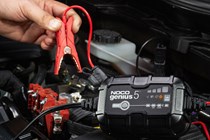Little signals the start of a frustrating day like trying to start your car and getting, at best, the slow and ineffectual churn of the starter motor that signals a dying battery. Most drivers have probably experienced it at some point, and while it can be frustrating, it can also be quite easy to fix – especially if you have a car battery charger to hand.
Whether you need a new battery, the car just needs a helping hand to start in cold weather, or if you inadvertently left the lights on for a few hours, a battery charger can get you back on the road again. Some models can even help revive a battery that’s on its last legs, letting you drive around for a little longer before having to buy a brand new battery.
In this guide we’ll explain what you need to know before charging your car’s battery, how to pick the right charger, how to use it, and how long you can expect it to take to charge. If your battery is dead and you need to get going a lot sooner though, it’s worth reading our guide on jump starting your car – and it may also be worth investing in a jump pack.
What do I need to know before charging a battery?
While your car’s manual might seem a little impenetrable, it’s the best place to start before charging your battery, as there may be useful information in there not just on charging, but information specific to your car – for instance, some battery chargers may not be compatible with all cars so you may need a specific type, while other cars may require a particular procedure. If you don’t have the manual, you may be able to find it online, or contact your local dealer for advice.
The charger will also have a user manual which will indicate the correct way to use it. If you’re happy you know what you’re doing, you can get started. Wearing appropriate safety gear is a sensible precaution. Gloves and safety glasses will prevent you getting injured by sparks or battery acid.
Note that cars with a stop/start system have a different type of battery, either an AGM or EFB battery. These are only compatible with smart battery chargers that recondition the battery as they charge it.
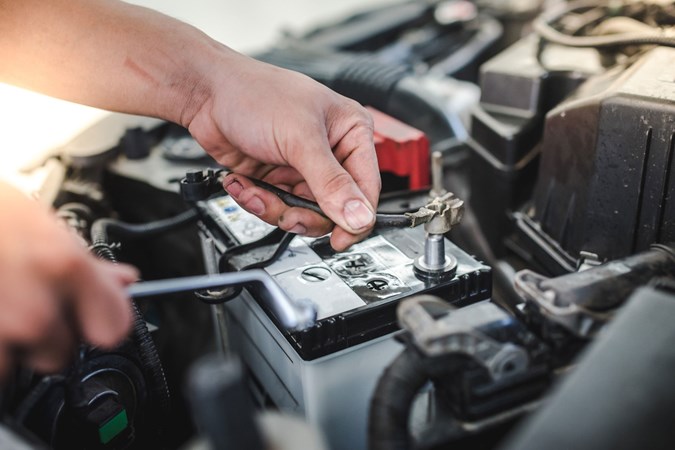
How to charge your car’s battery
Now you’re prepared, here’s the steps you need to follow when recharging a car battery:
Step 1: Locate your car’s battery
In most cars the battery will be located under the bonnet in the engine bay, which you’ll need to open using a handle in the cabin, typically somewhere under the dashboard. In some cars though – for instance, in most BMWs it’s located behind a side panel in the boot. Even if the battery is under the bonnet, access can be tricky. In some cars it’s in a box, in others pieces of plastic trim need to be removed to reach it. If you’re not confident about disassembling the car yourself, leave the job to a garage or breakdown service.
Step 2: Disconnect the battery
It’s possible to recharge a battery while it’s still connected to the car’s electrical system – again both the car’s user manual and the battery charger’s manual will advise you here – however it’s a sensible precaution to disconnect it, both for your own safety and to prevent the car getting damaged. Make sure all the car’s electrics and the ignition are turned off.
Disconnect the negative lead (usually the black one, but both positive and negative terminals should be clearly marked on the battery or battery connectors itself) first, undoing the bolts holding the clamp until it lifts off the terminal. Repeat the process for the positive (red) lead. It can be quite a fiddly job that’s made easier with a decent torque wrench.
Step 3: Clean the contacts
With the battery clamps removed, you can assess their condition and that of the terminals. If they’re rusty and/or dirty, they need cleaning. Rust can be removed with wire wool; all-purpose cleaner removes oil easily.
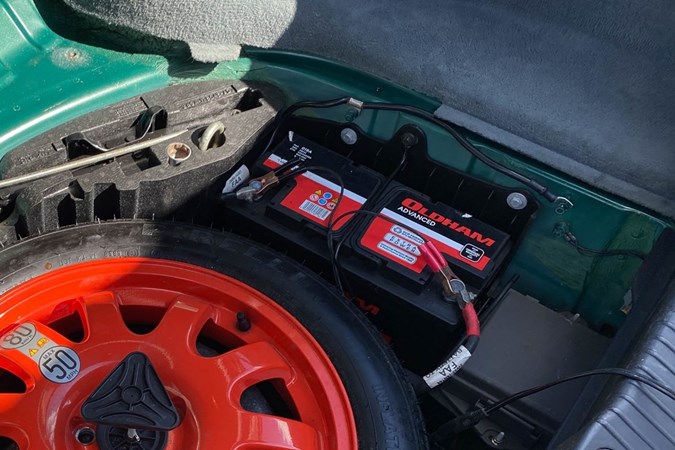
Step 4: Connect the charger
Attach the charger’s negative lead to the negative battery terminal, then attach the positive lead to the positive terminal. If you’re charging the battery while it’s still in the car, check the charger’s manual to see whether the charger needs to be earthed on an area of unpainted metal on the car like a bolt or bracket. Avoid anything connected to the fuel or electrical systems.
You should make sure the charger is positioned as far away from the car as possible – in other words, don’t place it in the engine bay or in an otherwise convenient-looking place on the car, and avoid putting it on a metal surface. Then plug the charger in. Some chargers can be quite bulky and heavy; a portable battery charger is lighter and easier to handle.
Step 5: Turn on the charger
Once the charger is turned on, it’s sensible to monitor progress periodically. Some chargers turn off automatically when the battery is fully charged, others need to be turned off. Chargers tend to have lights indicating what the device is doing at a given time, but reading the manual will make you familiar with exactly what to do.
Step 6: Disconnect the charger and reconnect the battery
When the battery is fully charged, disconnect the charger. Start with the positive lead, then the negative lead. Reconnect the battery’s negative lead, then the positive lead and refit any trim pieces that had to be removed. And then you’re done!
Do I need to disconnect a battery to charge it?
It’s not strictly necessary to disconnect a car’s battery before charging it. Consulting the manual for both car and charger should help you find out the best course of action. Nevertheless, many people prefer to disconnect the battery anyway, because it’s safer. You’re less likely to get a nasty shock and there’s a much lower change of shorting the car’s electrics.
The safest thing to do is removing the battery from the car entirely. In some cars that’s very easy, however in others access can be tricky with pieces of plastic trim in the way that need to be removed first. If you remove the battery from the car to charge it, then you should also ensure there’s plenty of space around wherever you place the battery and the area is fairly well ventilated. Lead-acid batteries can release hydrogen and oxygen while charging, neither of which you want to build up in large quantities in a confined space.
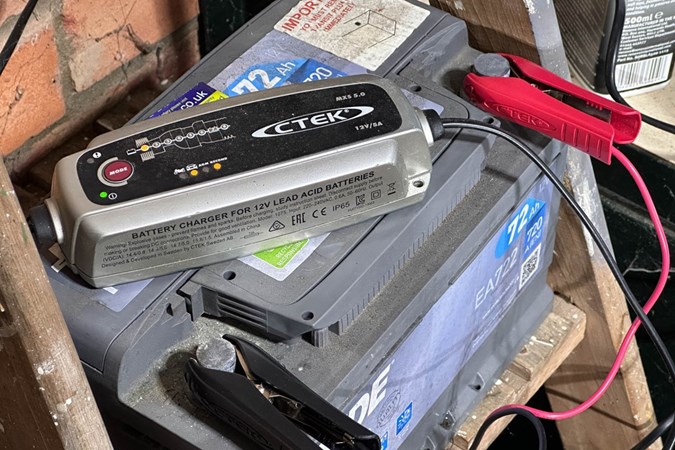
How do I connect a charger to a car’s battery?
It’s not strictly necessary to disconnect a car’s battery before charging it. Consulting the manual for both car and charger should help you find out the best course of action. Nevertheless, many people prefer to disconnect the battery anyway, because it’s safer. You’re less likely to get a nasty shock and there’s a much lower change of shorting the car’s electrics.
The safest thing to do is removing the battery from the car entirely. In some cars that’s very easy, however in others access can be tricky with pieces of plastic trim in the way that need to be removed first. If you remove the battery from the car to charge it, then you should also ensure there’s plenty of space around wherever you place the battery and the area is fairly well ventilated. Lead-acid batteries can release hydrogen and oxygen while charging, neither of which you want to build up in large quantities in a confined space.
How do I pick the right battery charger?
Most cars of the past fifty years or more use a 12-volt lead-acid battery. These are cheap, widely available, reliable, and easy to recycle at the end of their lives, and this type of battery is so common that you’ll even find it in hybrid and electric cars – albeit not for powering the car itself.
However, some cars do use other types of battery, especially in more modern vehicles. Many vehicles with a stop/start system use an ‘enhanced flooded battery’ (EFB), an ‘absorbent glass mat’ battery (AGM), or a gel-filled battery, all typically capable of more charging cycles than a traditional lead-acid battery. Some high-performance cars, such as certain Porsches, use a lightweight lithium-ion battery for their 12-volt systems.
Not all battery chargers are compatible with every type of battery. The labelling on the battery shows what sort it is, and you should corroborate it with the manual to make sure it’s the right one, as using the wrong kind of charger can cause damage both to the battery and the charger. If you’re still in doubt, speak to a dealer or retailer.
Once you’ve established what sort of battery your car has, you can set about finding a suitable charger. Keep an eye out for features such as reconditioning, which helps revive a tired battery, and diagnosis and maintenance modes that help prolong the life of the battery. For certain types of battery, you can only use a smart charger.
Battery chargers can be quite expensive but there are plenty of budget chargers available if you need to limit your spending. There are even solar-powered chargers that are useful if you don’t have access to mains electricity. Solar chargers are often designed to be used over extended periods of time, such as on a car that tends to live outside on your driveway and is rarely used, and some of the more expensive ones can be used as power banks when out and about.
The other key factor to look for is the charging current provided by the charger. This is rated in amps (A), generally in the 2-30 amp range for most consumer chargers. In theory, the higher the amperage, the quicker the charge.
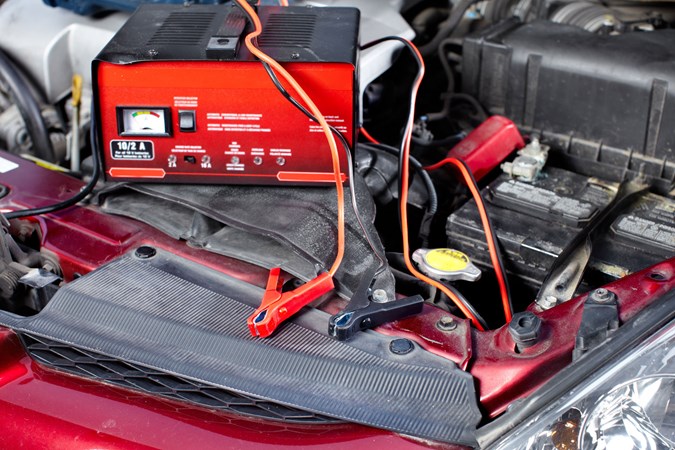
Is there an easier way to pick a charger?
The huge variety in battery chargers, and the different batteries they might be designed form, means finding exactly the right one can be a little time-consuming and confusing. Fortunately, there are some all-purpose chargers such as the NOCO Genius 10 that works with all types of lead-acid battery and lithium-ion ones.
If you need help, battery retailers and automotive outlets should be able to match your car’s battery to the right charger. Car dealers and garages can offer advice, as well.
Make sure you don’t inadvertently buy a battery maintainer, also known as a trickle charger. While they do recharge a battery, they do so very slowly. Of course, these devices can still be useful, particularly if you have a classic car or performance car that you drive only occasionally, but want to be in good working order on those rare occasions.
How long does it take to charge a car battery?
Every battery has an amp-hour (Ah) rating – that’s the number of amps it can put out in an hour. 50Ah is a typical rating, meaning the battery can put out 50 amps in an hour. The amps divide down with each passing hour, so that 50Ah becomes 25 amps over two hours, 16.6 amps over three hours and so on. You can find a car battery’s Ah rating on the label.
You can work out how long a car battery takes to recharge by dividing its Ah rating by the current the charger puts out. If the charger has a current of 10 amps (10A), that 50Ah battery will take five hours to recharge.
In theory. In reality, there are many factors that affect the rate at which a battery charges. They include the health of the battery, the state of the mains electrics the charger’s plugged into and malfunctioning electrics in the car.
Regardless, charging a battery for a few hours should be enough to get the car working again. Driving for a while afterwards should finish the job. If you have a flat battery and need to get going in a hurry, a jump-start pack will bring the car back to life – these devices usually pack enough punch to give you a couple of attempts at restarting your car, and many double up as power banks for electronic devices.

Are there other ways to maintain my car’s battery?
If you want to make sure your car’s battery lasts as long as possible, boosting your car’s reliability and reducing running costs, have a look at these basic battery care tips.
Just so you know, we may receive a commission or other compensation from the links on this website - read why you should trust us.



